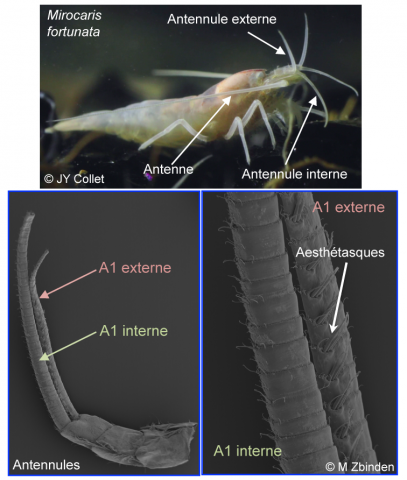
The detection of chemical signals is involved in a variety of crustacean behaviours, such as social interactions, search and evaluation of food and navigation in the environment. At hydrothermal vents, endemic shrimp may use the chemical signature of vent fluids to locate active edifices, however little is known on their sensory perception in these remote deep-sea habitats.
Here*, we present the first comparative description of the sensilla on the antennules and antennae of four hydrothermal vent shrimp (Rimicaris exoculata, Mirocaris fortunata, Chorocaris chacei and Alvinocaris markensis) and of a closely related coastal shrimp (Palaemon elegans). These observations revealed no specific adaptation regarding the size or number of aesthetascs (specialized unimodal olfactory sensilla) between hydrothermal and coastal species.
We also identified partial sequences of the ionotropic receptor IR25a, a co-receptor putatively involved in olfaction, in 3 coastal and 4 hydrothermal shrimp species, and showed that it is mainly expressed in the lateral flagella of the antennules that bear the unimodal chemosensilla aesthetascs.
* Comparative study of chemosensory organs of shrimp from hydrothermal vent and coastal environments
Zbinden M, Berthod C, Montagné N, Machon J, Léger N, Chertemps T, Rabet N., Shillito B, Ravaux J. Chemical senses 2017, 42 (4): 319-331. https://doi.org/10.1093/chemse/bjx007
BOREA contact: Magali Zbinden, assistant professor UPMC, magali.zbinden@upmc.fr
